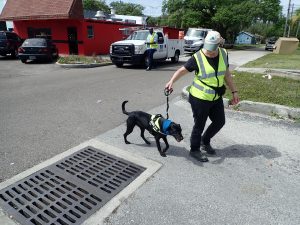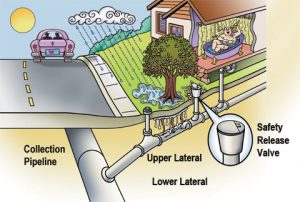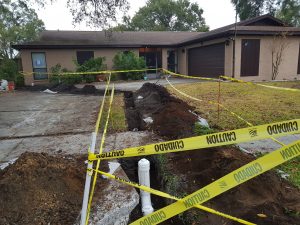
Photo by Heather Young.
[printfriendly] We’ve all heard amazing stories about search-and-rescue dogs finding people in burning buildings or snowy mountains. But how about sewer-sniffing pups like Kush and Remi who visited St. Petersburg earlier this year to track down high levels of human waste washing into Tampa Bay?
Part of the team at Environmental Canine Services, the dogs can smell odors at concentrations of up to 100 million times lower than humans can — and distinguish the scent of human waste from that of other animals. “It’s very hard to differentiate between animal waste and human waste, said Karen Reynolds, an owner and founder of ECS. “It usually requires a very expensive DNA test to determine which is which – except for dogs that have been trained to detect human waste only.”
She and her husband were both dog trainers until he went back to school to become a scientist, Reynolds said. “Then the question arose: why not use dogs to test water quality? We were already training dogs for search-and-rescue and security, so it was just another step in the process to teach them to alert for human waste.”
The city has been investigating the source of water quality issues in the Salt Creek watershed using microbial DNA tests but having the dogs helped to narrow down those sources, said Kira Barrera, special projects manager. And while they’re still waiting for final results, it’s not the homeless people who are camping along its shoreline.
“It’s not from the homeless camps – the places we’re seeing human indicators couldn’t be re-created without 100 people pooping in the creek or someone illegally dumping truckloads of wastewater,” she said.
Lateral Lines to Blame?

Along with the possibility of illicit dumping, city officials are looking at the options of sewer lines mistakenly or illegally connected to stormwater drains. “It’s a possibility,” said Mike Perry, a civil engineer focused on stormwater and environmental design. “It’s usually a mistake because wastewater fees are automatically calculated based on water use. I’ve seen cases where a construction crew didn’t follow the correct drawings and connected to the wrong pipe though.”
Another potential cause – almost certainly creating at least part of the problem – is the lateral lines that connect individual homes to the city’s wastewater lines. “In the older parts of town, some of those lines are more than 100 years old,” Barrera said.
Those lines – nearly 100,000 in the city’s service areas – also may be constructed of materials that are no longer acceptable in more recent building codes. Orangeburg, used extensively through the 1970s, is basically wood pulp sealed with hot asphalt. Its useful life is estimated at 50 years under ideal conditions, but it can fail in as few as 20 years.

Photo by Vicki Parsons.
Other options before plastic piping was readily available included cast iron and concrete, both of which have the potential for leaking after decades of service. Along with its probable age, cast iron is affected by extreme weather changes as well as mature trees that may grow into the line. Concrete lines can also become compromised by tree roots that may crack the pipe and cause significant leaking.
“People don’t know their lateral lines are leaking until wastewater backs up into the house,” Perry said. “Then they pay attention.”
Dogs are Affordable Option
Microbial source tracking – including a new methodology developed with the University of South Florida – provides a firm base for the dogs to start sniffing, but they are helping to narrow the source down, Barrera said. “They’ve been really affordable to use and helped us tighten up those target areas.”

In fact, the dogs have been so effective that they “alerted” at spots with very low fecal counts – so low they were below the level at which any action is required, Barrera said.
Typically, the cost of the sewer-sniffing pups is about equal to the cost of a professional taking samples, said Reynolds, a professional dog trainer married to an environmental scientist
ECS provides two dogs so that all alerts are verified, Reynolds adds.
(The pups, for die-hard dog fans, are mostly rescued dogs and are never shipped by airplane. ECS travels to clients by automobile to ensure the safety of the dogs.)
“A classic urban watershed”
Salt Creek is the “classic urban watershed” running about a mile northwest through the mostly developed land between Lake Maggiore and Bayboro Harbor, a port serving the U.S. Coast Guard, the University of South Florida St. Petersburg, as well as commercial shipping operations and a marina. Once a navigable body of water, now it’s more of a neighborhood creek and stormwater canal, providing food and shelter for wildlife from, birds and butterflies to fish and the occasional alligator.
Traversing throughout several neighborhoods, the Salt Creek watershed is considered impaired for both nutrients and bacteria. it is among the watersheds in the city with the largest number of Enterococci exceedances. Since Salt Creek empties into one of the city’s most heavily used harbors, it was critical to track sources to locations where they could be prevented, Perry said.
“We covered a lot of ground in two days with the dogs, much more than we could have done without them,” he said. An in-depth report is expected later this month.
[su_divider]
